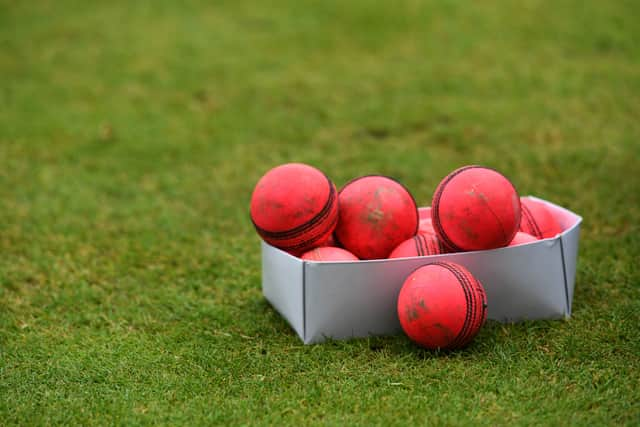Ashes 2021/22: why is a pink cricket ball being used in the 5th Test between Australia vs England in Hobart?
and live on Freeview channel 276
Hobart has finally been decided as the ground to host the final Ashes series in what has been a near catastrophic disaster for England.
With England coming into their final match 3-0 down, they will only have pride left to play for as they hope to take advantage of the English-like conditions at the ground.
Advertisement
Hide AdAdvertisement
Hide AdNot only will England hope to come away without a 4-0 defeat, certain players will be playing for their future in the squad.
There will be some serious questions asked about England’s Test cricket preparation and mindset following the conclusion in Australia with many players hoping to survive what may well be a culling in the team.
Haseeb Hameed initially looked to be a steady option for opening batsman but has since done little of note that would make his place in the squad seem anything but shaky, while Jonny Bairstow will hope to capitalise on the century he made in Sydney.


For the final test in Tasmania, we will once again be treated to the pink ball and the day/night format of the Tests.
Advertisement
Hide AdAdvertisement
Hide AdThe day/night Tests bring its own challenges and one of the notable differences between these Tests and the normal 11am starts is the ball. A traditional red ball is used in day tests with the option of a new ball every 80 overs. However, a pink ball was introduced into Test cricket for the first time in 2015 when Australia played New Zealand in the first ever day/night test match.
Here is all you need to know about the pink ball and the history of day/night Test cricket
When were day/night Tests first introduced?
Matches were played under floodlights as early as the 1950s but it wasn’t until the 2000s that there was the possibility of Test matches being played in the same environment.
The first floodlit first-class match where a pink ball was used was played between Guyana and Trinidad and Tobago in 2009
Advertisement
Hide AdAdvertisement
Hide AdThe pink ball was also trialled by Cricket Australia and some Indian Premier League and Bangladesh Cricket League franchises.


The 2013-14 Sheffield Shield season included three-day/night first-class matches with pink balls but the first time the pink ball was used in an international capacity was during the first ever day/night Test match in 2015. Australia hosted New Zealand at the Adelaide Oval and a pink ball was used.
England played their first ever day/night test in 2017 during their home series against the West Indies. The match took place at Edgbaston and England won by an innings and 209 runs thanks to a double century from Alastair Cook and a century from Joe Root.
Why do day/night Tests use a pink ball?
Quite simply the pink ball helps with visibility when the floodlights are turned on and the hours of darkness arise.
Advertisement
Hide AdAdvertisement
Hide AdThe traditional red ball is unsuited for the day/night tests as it becomes harder to see when the sun goes down. If Test matches are played later into the evening, fast bowlers are often asked to step down and it is only spinners who are allowed to bowl as the visibility of a fast ball becomes too dangerous when the light decreases.


Additionally, the white ball which is used in one-day cricket is conditioned to deteriorate more quickly and cannot be used for eighty overs, as specified in the cricket rules.
The pink ball was therefore designed in order to create a compromise on both the issues. It is considered still more difficult to see than the white ball but the leather is more heavily dyed than the red ball, preserving the colour and visibility more effectively while also giving it slightly different wear characteristics.
Are there other differences between a red and pink cricket ball?
It is likely that the differences between the two Test cricket balls would very much depend on the manufacturer. Duke, Sanspareil Greenlands and Kookaburra all use different seams for different coloured balls but the pink ball is much closer to the red than most believe.
Advertisement
Hide AdAdvertisement
Hide AdDespite the common theory that the pink balls are lighter, there is in fact no difference in weight. All cricket balls, including the white balls, weigh between 156 and 162 grams.
Scientists have also tried to squash the theory that the pink ball swings more than the red. This action would most definitely favour the bowlers, especially James Anderson who has often been dubbed the ‘King of Swing (bowling)’.
Dr Rabindra Mehta, an experimental aerodynamic scientist at NASA spoke to the Indian Express saying: “All the other perceptions of the pink ball I believe are just plain rubbish, including this theory that it swings more during the twilight session.
“As far as the ball and its properties are concerned, that’s not going to change with respect to the weather conditions. I have written many, many articles and have said categorically that the weather has no effect on the swing.”
Advertisement
Hide AdAdvertisement
Hide AdEngland play their second Test in Adelaide on Thursday 16 December 2021 and play begins at 4am GMT every morning.
A message from the editor:
Thank you for reading. NationalWorld is a new national news brand, produced by a team of journalists, editors, video producers and designers who live and work across the UK. Find out more about who’s who in the team, and our editorial values. We want to start a community among our readers, so please follow us on Facebook, Twitter and Instagram, and keep the conversation going. You can also sign up to our newsletters and get a curated selection of our best reads to your inbox every day.
Comment Guidelines
National World encourages reader discussion on our stories. User feedback, insights and back-and-forth exchanges add a rich layer of context to reporting. Please review our Community Guidelines before commenting.
